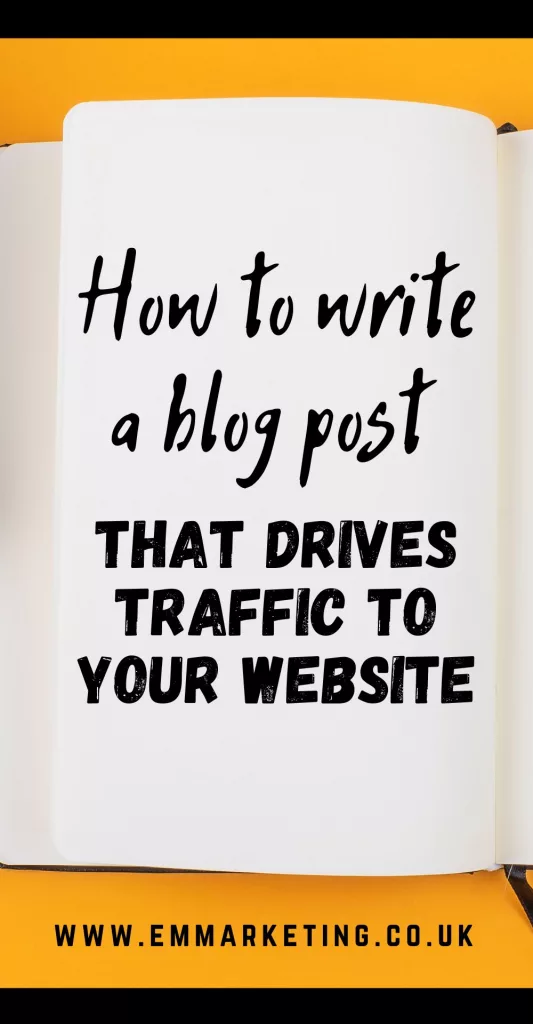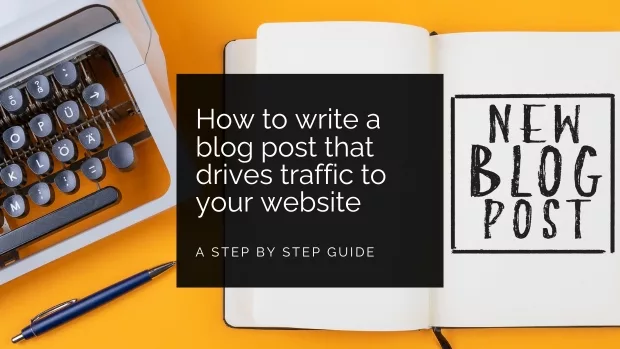Table of Contents
Introduction
If you’re a small business owner with a website, adding a blog is an excellent addition to your marketing strategy. Why? A blog is not only a great way to engage with your audience and showcase your expertise, but you can also use it to drive traffic to your website using your other marketing channels like Pinterest and social media, to name just two. Your increased traffic will hopefully result in additional clients but also when your blog gets enough traffic, you can monetise it to give you an extra revenue stream. Sounds good, right? But I know that while many small business owners would love to add a blog to their website, they don’t because they don’t know how to write a blog post that drives traffic.
So that’s what this blog post is about. A step-by-step guide to help you write blog posts that engage your readers and are optimised so you can use your blog to drive traffic to your website and ultimately earn you more money.
Choose the right platform
First up, if you’re looking to monetise your blog, albeit in the future, the best platform to use is WordPress.org. Don’t worry if your main website isn’t a WordPress one, you can add a WordPress.org blog to most websites. Be careful not to confuse WordPress.org with WordPress.com. You want the .org version to be able to run ads.
Choose your topic and do keyword research
Before you start any writing, there’s research to do. As with all marketing, it’s important to know your audience. Think about who they are (you should have this listed in your marketing strategy) and what they are interested in. Your blog should offer valuable content that answers the common questions your audience asks or provides solutions to the problems they face.
Example
Let’s say you have a kid’s party business (I use this example because I had one, and I used a blog to successfully drive traffic to my website). Your topic could be kid’s party planning. If you type kids party planning into Google, you will automatically start to find questions people have previously asked, and within those questions are keywords. Try this with a number of search tools, including Pinterest, to build your keyword list. Additionally, there are free tools you can use, like AlsoAsked to help you find relevant keywords. You’ll notice the terms keywords and keyphrases are often used interchangeably; the only difference is keywords are single words, and keyphrases are made up of a few words. Choose one keyword or phrase from your list to build your post around and save the others for future posts.
As a small business, the best keywords are those that have less competition. The higher the search volume for your keyword, the less chance you have of being found in search, so very specific and niche keywords and phrases are the ones to go for. These are known as long-tail keywords. I recently ranked on page 2 of Google with my Mailchimp Best Practice Tips blog, which is pretty niche, so it is doable. You can check the search volume for keywords using websites like Ubersuggest. Your keyword or phrase forms the foundation of your blog post, so it’s important not to skip this step.
Write your blog outline
Much like a marketing email, the structure of your blog is as important as the content. That’s why I always start with my outline before I write any copy. Here are the steps to take.
Write your title
Your title or headline is the first thing readers will see and so plays a big part in whether or not they will click on your blog to read more, but it also sets the scene for what you are about to write, so that’s why I write it first and build my copy around it rather than the other way around. Make your title descriptive but concise and ideally incorporate your keyword. You can check the quality of your headline using the Monster Insights headline analyser tool.
Structure your post
Headings are really important when it comes to blog writing. From your reader’s perspective, they make your article easier to read and navigate. Ideally, you want to make your article skimmable. If you write your headings first, you can then go back and fill in the sections with the copy. This helps to keep your article focused and concise. Headings also help Google understand your content better, so it’s important to use the right structure. When formatting your blog, be sure to use the following heading structure:
- H1: The main title of your blog (should include your keyword). Each page/post on your website should only have one H1 title.
- H2: Subheadings for main points in the article (also include related keywords here if possible).
- H3: Further subheadings or details under H2 headings.
There are a further 3 tags for headings, H4-H6, but you will probably only need H1-H3, as H4 onwards will make your structure complex.
I’m a visual person, so for me, it helps to understand this by seeing a visual example. Here’s an example with my titles and subheadings in this blog post:
- H1: How to write a blog post that drives traffic to your website
- H2: Introduction (subheading)
- H2: Choose the right platform (subheading)
- H2: Choose your topic and do keyword research (subheading)
- H3: Example (further subheading that sits under H2)
- H2: Write your blog outline (subheading)
- H3: Write your title (further subheading that sits under H2)
- H3: Structure your post (further subheading that sits under H2)
- H3: Write your content (further subheading that sits under H2)
- H2: Add images (subheading)
- H2: Optimise for SEO (subheading)
- H2: Proofread and publish (subheading)
- H2: Conclusion (subheading)
Write your content
When it comes to the content of your post, focus on providing value. Start with a strong introduction that hooks your reader in. I also include a table of contents at the start using a free plugin. This helps to make the post skimmable, and it means readers can skip to the section they want to if they don’t have time to read the full post.
Keep to your structure and edit your copy well to ensure you stick to your main points. This will stop people from losing interest and leaving your blog/website. Break up large chunks of text with short paragraphs, bullet points, and lists to improve readability.
Always end with a clear call to action and/or a clickable link (there’s more on that coming up). Ideally, you want to direct your audience to a sales page or your opt-in for them to engage further.

Add images
Blog posts have one feature image (a bit like your one H1 title). Be sure to create a feature image for each post and use a text overlay. Adding the text overlay will help people to understand what your post is about if the image appears in image-only search results and will help to encourage people to click through from search to your blog.
Additional images and infographics will help make your blog post more engaging and shareable. People are more likely to stay on your page longer if there’s something to catch their eye. Images are also a great way to break up copy.
Add a Pin-It plug-in to your website so people can pin images from your blog to their Pinterest account, which could help with additional traffic.
When adding images, make sure they are relevant to the content and optimised (compressed to below 250 KB to avoid slow loading times).
Optimise for SEO
Keywords are part of SEO, but there are other SEO best practices that will help your blog post. Use the free version of Yoast to get started. Yoast uses a traffic light system to guide you through the areas you need to work on, including things like:
- Meta description: A short (150-160 characters) description that summarises your post and incorporates a keyword where appropriate. This appears below your title in search results.
- Internal links: Links to other relevant pages or blog posts on your website. This not only helps readers navigate but also helps search engines, so it helps with SEO. Make sure the anchor text (the clickable part of the link) is descriptive and natural, rather than just using “click here.”
- External links: Links to authoritative, relevant sources (for instance, linking to research or resources such as the Yoast link I’ve used above). As above, make sure the anchor text is descriptive and natural, rather than just using “click here.”
- Alt text for images: Include alt text that describes your images and incorporates a keyword where appropriate. This helps search engines index your images and improves accessibility.
Yoast also checks for how often you use your keyword so you get the balance right by using it naturally in your copy without keyword stuffing.
Proofread and publish
Before you hit publish, carefully proofread your article for grammar and spelling mistakes. It’s also a good idea to read through it from your reader’s perspective to make sure the flow is natural and engaging. Using tools like Grammarly and Scribbr will help catch errors and improve readability. When you’re happy, it’s time to publish your post!
But the work doesn’t end there. Use Pinterest to create pins that link to your blog post to drive traffic to your website. Share your blog on your social media channels, send your blog to your email list, and encourage your followers to comment or share to encourage further traffic.
And remember, blog posts are easy to update. You may notice something you want to update straight away, but it’s also a good idea to revisit blog posts quarterly to see if you can extend their lifecycle by making relevant updates.
Conclusion
Starting a blog is a great way for you as a small business to connect with your audience, establish authority, and boost website traffic, but it’s not a quick win. It takes time, research, consistency, and patience. By choosing the right topics and keywords, optimising your content for SEO, using a clear writing structure, and ending with a clear call to action, you’ll create blog posts that provide value to your readers and, in time, will help grow your business and bring in more revenue.
If you’re ready to take your website to the next level and add a blog but need some help, drop me a message by clicking here, and we’ll work on it together.


Leave a Reply